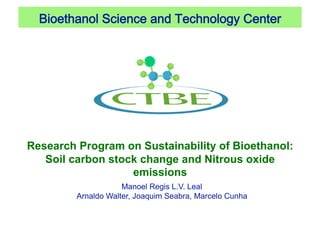
Research Program on Sustainability of Bioethanol: Soil carbon stock change and Nitrous oxide emissions
- 1. Bioethanol Science and Technology Center Research Program on Sustainability of Bioethanol: Soil carbon stock change and Nitrous oxide emissions Manoel Regis L.V. Leal Arnaldo Walter, Joaquim Seabra, Marcelo Cunha
- 2. The main goals • The priority in this project is data collection that could increase the precision of the GHG balance results, by taking in account the direct effects of land use change and the impacts of the changes in the production process (e.g., green cane harvesting, trash left on the ground, no till system, etc.). • One boundary condition is that the database must be representative, reliable and of free access.
- 3. Required actions: soil carbon stock change • To build this database it will be necessary the evaluation in different types of soil (e.g., in degraded pasture areas, cultivated pasture, areas with soybeans, corn, orange and other crops) and in areas with different sugarcane agriculture management (in some of them the evaluation can only take place in the future – e.g., areas with no till cultivation).
- 4. Required actions: nitrous oxide emissions • The main objective is also the collection of reliable data that could improve the results of the GHG emission balances. • What is important in this case is to quantify nitrous oxide emissions as a function of the specific agricultural practices in sugarcane cultivation (e.g., the quantity of fertilizer/vinasse application, type of soil, cropping technique used, etc.). • All foreseen changes in sugarcane cultivation must be considered. • Once more, the resulting database must be representative, reliable and of free access.
- 5. Data collection • Traditional areas of sugarcane cultivation, as well as areas for potential expansion of the culture, will be prioritized for the data collection. • In principle, it is proposed that the activities will take place in the state of São Paulo, in the Center–South region (on state or region) and in the Northeast. • The areas/regions to be evaluated will be defined based on the higher probability of hosting the sugarcane expansion and, in this sense, the information of the LUC project will be used (as well as all available information).
- 6. CTBE’s role • Firstly, fostering the activities of groups with previous activities in this issue (two research groups could be partners and negotiations are ongoing). • Secondly, the CTBE's Basic Research group will have technical people and laboratory facilities that could be used as well. • In addition, CTBE’s action will include compilation of the available information and its analysis.
- 7. Results within one year • Compiled database on soil carbon stocks for sugarcane crop. • Preliminary data of other crops.
- 8. Following presentations • Carlos C. Cerri (CENA-USP): Working Proposal of CENA’s Soil Carbon Group. • Robert M. Boddey (EMBRAPA Agrobiologia): Greenhouse Gas Emissions in the Bioethanol Production Cycle from Sugarcane: what we know and what we still need to know.
- 9. Thanks for your attention!! Questions?
